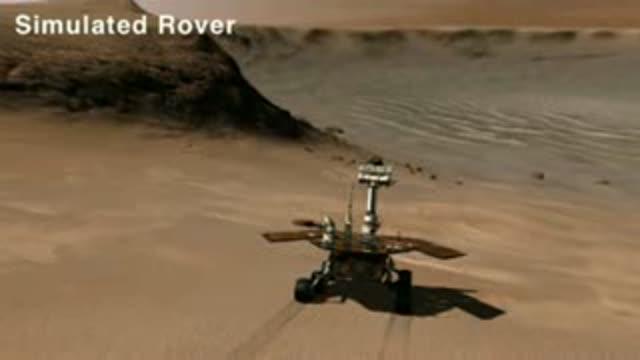"But operating at 100 to 200 megabits per sol, we've attempted to reconstruct the past environment from the geologic record just as a field geologist would do. (Sols, or Martian days, are 39 minutes longer than Earth days.)
"We lost Spirit, Opportunity's twin, back in 2010," Arvidson said. Stuck in the sand, it was unable to point its solar arrays in the correct direction to survive winter, and it went quiet March 22, 2010, or sol 2,210.
But Arvidson is not complaining; the rovers were expected to survive only about 90 to 180 sols. "They were supposed to last three or six months and it's been 10 years," he said. "They were supposed to drive maybe a thousand meters, and Opportunity is now about to break 40,000 meters."
Crater-hopping on Mars
Early in its mission although already past its expiry date (on sol 134), Opportunity drove into a 430-foot-wide crater named Endurance. It spent the next half-year exploring sedimentary layers exposed in the crater wall.
They were named the Burns formation for Roger Burns, a geologist who predicted the importance of sulfate mineralogy on Mars based on results obtained by the Viking missions and his laboratory analyses. "The formation consists of many thin layers of sulfate sandstone that formed in ancient lakebeds, were reworked into sand dunes by the wind, and then recemented into rock by rising groundwater," Arvidson said.
Looking at the chemistry of the rocks, the mission scientists inferred that they had formed under acidic and oxidizing conditions. The rover, they quipped, had discovered evidence not of water but of acid on Mars.
Nothing daunted, Opportunity struggled out of Endurance and trundled off toward Argo, the next-nearest crater. It was to crater-hop for the next nine years, checking out Argo, Vostok, Erebus, Victoria, Conception and Santa Maria, but encountering the Burns Formation everywhere it went.
And then, finally, it drove to Endeavour, a monster crater, measuring a full 14 miles across. Formed by the impact of an asteroid or a comet, perhaps 4 billion years ago, the crater has been filled in by Burns Formation sandstones, but a few islands of rock still stand exposed on the rim.
"They're ancient rocks that predate the Endeavour impact," Arvidson said. Rather than enter the crater, Opportunity stayed on its rim to look at those rocks.
"We drove to a spot on the rim called Cape York because the CRISM instrument on the Mars Reconnaissance Orbiter had identified the spectral signature of clay materials on its eastern side," Arvidson explained.
At Cape York, the rover ground into a rock called Espérance. The deeper it ground, the more the rock's composition resembled that of an aluminum-rich clay called montmorillonite.
"To make an aluminum-rich clay," Arvidson explained, "you have to leach many other elements out of the rock, such as iron and magnesium. So this is a place a lot of water flowed through, probably because fracturing made the rock very permeable.
"If you go through the chemistry and infer characteristics of the water, it was mildly acidic at best and reducing, not oxidizing, and those are habitable conditions. We think this kind of environment existed many places on Mars," he said.
What happened to Mars?
But if Mars was once warm and wet, what happened to turn it cold and dry?
"Early Mars was volcanically active," Arvidson said. "The volcanoes would have pumped greenhouse gases into the atmosphere that warmed the planet. It also had an internal magnetic field that deflected the solar wind, preventing it from stripping away the atmosphere. But as the core of the planet froze, its magnetic field diminished, the solar wind scoured away the atmosphere, and without a dense atmosphere, it became the cold, dry planet we know today.
"That's what the geologists think," he said. "So we're convincing the atmosphere modelers to give us enough greenhouse oomph, with whatever gas they want, in order to get up to temperature where there would be liquid water on the surface. Because the geological evidence says, 'That's a fact, Jack.'"
The Boffins-in-training all stood up and cheered.

Ray Arvidson, deputy principal investigator on the MER mission to Mars, gives of a whirlwind tour of the rover's adventures and discoveries over the past 10 years.
(Photo Credit: WUSTL)

Ray Arvidson, deputy principal investigator of the MER mission, celebrates the Opportunity rover's 10th anniversary on Mars, which coincides with his 40th anniversary at Washington University in St. Louis.
(Photo Credit: Randy Korotev)